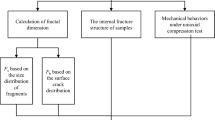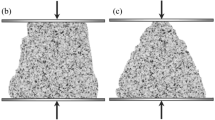Abstract
A correlation study between the fracability and brittleness of shale gas reservoir is crucial for optimize reservoir reconstruction and enhance shale gas recovery. To investigate the relationship between fracability and brittleness of shale, a series of uniaxial compression tests of Silurian Longmaxi shale samples were carried out using a novel setup that combines X-ray micro-computed tomography with a uniaxial loading apparatus. Based on the CT images obtained from the test, fractal dimension of crack distribution that regarded as an effective index describing the fracability of shale was estimated, and the Weibull shape parameter that deemed as a reliable index to describe the brittleness of shale was calculated. The ratio of fractal dimension and Weibull shape parameter was close to a constant value of 2. To reveal the relationship between the fractal dimension and Weibull shape parameter, the quantitative relationship between the fractal dimension of the crack distribution and the Weibull shape parameter of the shale under tensile and compressive stress conditions was established by coupling the fracture mechanics and Weibull’s weakest-link theory, which validated that the shale fracability was directly proportional to its brittleness. The applicable range of the quantitative relationship showed that the proportional relationship only held for a low-brittleness shale. These results are significant for the fracturing and recovery of shale-gas reservoirs.
Article Highlights
-
Uniaxial compression experiments of shale were conducted using novel X-ray microscopy, and three-dimensional CT reconstruction images with a time series were obtained.
-
Laboratory test results analyzed the qualitative relationship between shale fracability and brittleness.
-
A quantitative relationship between shale fracability and brittleness was established by coupling fracture mechanics and Weibull’s weakest link theory.









Similar content being viewed by others
References
Altindag R (2003) Correlation of specific energy with rock brittleness concepts on rock cutting. J S Afr Inst Min Metall 103(3):163–171
Amaral PM, Fernandes JC, Rosa LG (2008) Weibull statistical analysis of granite bending strength. Rock Mech Rock Eng 41(6):917–928
Aviles CA, Scholz CH, Boatwright J (1987) Fractal analysis applied to characteristic segments of the San Andreas Fault. J Geophys Res 92(B1):331–344
Bai M (2016) Why are brittleness and fracability not equivalent in designing hydraulic fracturing in tight shale gas reservoirs. Petroleum 2(1):1–19
Batdorf SB (1978) Fundamentals of the statistical theory of fracture. In: Bradt RC, Hasselman DPH, Lange FM (eds) Proceedings of the international symposium on fracture mechanics of ceramics. Plenum Press, New York, pp 1–30
Beyer JA, Alsleben H, Enderlin M (2011) Predicting fracability in shale reservoirs. In: AAPG annual convention and exhibition, Houston, TX, USA, pp 10–13
Boersma T, Johnson C (2012) The shale gas revolution: U.S. and EU policy and research agendas. Rev Policy Res 29(4):570–576
Cao WG, Zhang S (2005) Study on the statistical analysis of rock damage based on Mohr–Coulomb criterion. J Hunan Niv (Nat Sci Ed) 32(1):43–47
Chen HR, Qin SQ, Xue L, Yang BC, Zhang K (2018) A physical model predicting instability of rock slopes with locked segments along a potential slip surface. Eng Geol 242:34–43
Chen HR, Qin SQ, Lei X, Yang BC, Zhang K, Wu XW (2017) Characterization of brittle failure of rock and limitation of Weibull distribution. Prog Geophys 32(5):2200–2206
Chong KK, Grieser WV, Passman A, Tamayo HC, Modeland N, Burke BE (2010) A completions guide book to shale-play development: a review of successful approaches toward shale-play stimulation in the last two decades. In: Canadian unconventional resources and international petroleum conference
Curtis JB, Montgomery SL (2002) Recoverable natural gas resource of the United States: summary of recent estimates. AAPG Bull 86(10):1671–1678
Duan YT, Li X, He JM, Li SD, Zhou RQ (2018) Quantitative analysis of meso-damage evolution for shale under in situ uniaxial compression conditions. Environ Earth Sci 77(4):154
Duan YT, Li X, Zheng B, He JM, Hao J (2019) Cracking evolution and failure characteristics of Longmaxi shale under uniaxial compression by using real-time computed tomography scanning. Rock Mech Rock Eng 52(6):3003–3015
Duan YT, Li X, Ranjith PG, Wu YF (2020) An investigation of the evolution of the internal structures and failure modes of Longmaxi shale using novel X-ray microscopy. J Pet Sci Eng 184:106479
Gao F, Zhong WP, Li LY, Xie HP (2004) Fractal and statistical analysis of strength of jointed rocks. Chin J Rock Mech Eng 23(21):3608–3612
Guo T (2013) Evaluation of highly thermally mature shale-gas reservoirs in complex structural parts of the Sichuan Basin. J Earth Sci 24(6):863–873
Hajiabdolmajid V, Kaiser PK, Martin CD (2002) Modelling brittle failure of rock. Int J Rock Mech Min 39(6):731–741
He ZL, Hu ZQ, Nie HK, Li SJ, Xu J (2017) Characterization of shale gas enrichment in the Wufeng Formation-Longmaxi Formation in the Sichuan Basin of China and evaluation of its geological construction–transformation evolution sequence. Nat Gas Geosci 2(1):1–10
Hirata T, Satoh T, Ito K (1987) Fractal structure of spatial distribution of microfracturing in rock. J Geophys Res 90(2):369–374
Huang J, Song ZL, Liao ZW, Zhao WC, Wang D (2020) Quantification of cracks and the evolution of permeability for reservoir rock under coupled THM: equipment development and experimental research. Geomech Geophys Geo-energy Geo-resour 6:63
Hucka V, Das B (1974) Brittleness determination of rocks by different methods. Int J Rock Mech Min 11(10):389–392
Hughes JD (2013) A reality check on the shale revolution. Nature 494(7437):307–308
Jarvie DM, Hill RJ, Ruble TE, Pollastro RM (2007) Unconventional shale-gas systems: the Mississippian Barnett Shale of north-central Texas as one model for thermogenic shale-gas assessment. AAPG Bull 91(4):475–499
Jin X, Shah SN, Roegiers JC, Zhang B (2015) Fracability evaluation in shale reservoirs—an integrated petrophysics and geomechanics approach. SPE J 20(3):518–526
Kerr RA (2010) Natural gas from shale bursts onto the scene. Science 328(5986):1624–1626
Krajcinovic D, Silva MAG (1982) Statistical aspects of the continuous damage theory. Int J Solids Struct 18(7):551–562
Liao ZY, Ren M, Tang CA, Zhu JB (2020) A three-dimensional damage-based contact element model for simulating the interfacial behaviors of rocks and its validation and applications. Geomech Geophys Geo-energy Geo-resour 6:45
Lemaitre J (1984) How to use damage mechanics. Nucl Eng Des 80(2):233–245
Li SY, He MT, Yin XC (2015) Rock fracture mechanics. Science Press, Beijing
Liu P, Ju Y, Gao F, Ranjith PG, Zhang Q (2018) CT identification and fractal characterization of 3-D propagation and distribution of hydrofracturing cracks in low-permeability heterogeneous rocks. J Geophys Res 123:2156–2173
Matsuo Y (1981) Statistical fracture theory for multiaxial stress states using Weibull’s three-parameter function. Eng Fract Mech 14(3):527–538
Munoz H, Taheri A, Chanda EK (2016) Rock drilling performance evaluation by an energy dissipation based rock brittleness index. Rock Mech Rock Eng 49(8):3343–3355
Nakamura AM, Michel P, Setoh M (2007) Weibull parameters of Yakuno basalt targets used in documented high-velocity impact experiments. J Geophys Res 112(E2):1–7
Peng TR, Zhang ZH (1989) Distributed functions of fracture size and their applications in fatigue statistical analysis. J Shandong Inst Build Mater 3(3):1–10
Roshan H, Sarmadivaleh M, Iglauer S (2016) Shale fracture surface area measured by tracking exchangeable cations. J Pet Sci Eng 138:97–103
Sahimi M (1993) Flow phenomena in rocks: from continuum models to fractals, percolation, cellular automata, and simulated annealing. Rev Mod Phys 65(4):1393–1534
Sahimi M, Yortsos YC (1990) Applications of fractal geometry to porous media: a review. In: the Annual Fall Meeting of the Society of Petroleum Engineers
Stach S, Cybo J (2003) Multifractal description of fracture morphology: theoretical basis. Mater Charact 1(51):79–86
Sui L, Ju Y, Yang Y, Yang Y, Li A (2016) A quantification method for shale fracability based on analytic hierarchy process. Energy 115:637–645
Tang CA, Liu H, Lee PK, Tsui Y, Tham L (2000) Numerical studies of the influence of microstructure on rock failure in uniaxial compression—part I: effect of heterogeneity. Int J Rock Mech Min 37(4):555–569
Tang CA, Wang SH, Fu YF (2003) Numerical test of rock failure. Science Press, Beijing
Tang X, Xu S, Zhuang C, Su Y, Chen X (2016) Quantitative evaluation of rock brittleness and fracability based on elastic-wave velocity variation around borehole. Pet Explor Dev 43(3):457–464
Wang WW (2009) Study on the interaction and merging condition of multiple. Nanjing University of Technology, Nanjing
Wei G, Tang J (2009) Study of minimum box-counting method for image fractal dimension estimation. In: 2008 China international conference on electricity distribution
Wong T, Wong RHC, Cha KT, Tang CA (2006) Microcrack statistics, Weibull distribution and micromechanical modeling of compressive failure in rock. Mech Mater 38(7):664–681
Wu J, Zhang S, Cao H, Sun P, Luo X (2017) Fracability evaluation of shale gas reservoir-A case study in the Lower Cambrian Niutitang formation, northwestern Hunan, China. J Pet Sci Eng 164:675–684
Xue L, Qin SQ, Li P, Li GL, Oyediran IA, Pan XH (2014) New quantitative displacement criteria for slope deformation process: from the onset of the accelerating creep to brittle rupture and final failure. Eng Geol 182(Part A):79–87
Yang BC, Qin SQ, Xue L, Chen HR, Wu XW, Zhang K (2017) A physical self-similarity law describing the accelerated failure behavior of rocks. Chin J Geophys 60(5):1746–1760
Yang BC, Xue L, Wang MM (2018a) An evaluation index for the fracturing effect in shale based on laboratory testing. Environ Earth Sci 77(6):240
Yang BC, Xue L, Wang MM (2018b) Evolution of the shape parameter in the Weibull distribution for brittle rocks under uniaxial compression. Arab J Geosci 11(12):1–7
Yang BC, Xue L, Zhang K (2018c) X-ray micro-computed tomography study of the propagation of cracks in shale during uniaxial compression. Environ Earth Sci 77(18):652
Yang R, He S, Wang X, Hu Q, Hu D, Yi J (2016) Paleo-ocean redox environments of the Upper Ordovician Wufeng and the first member in lower Silurian Longmaxi formations in the Jiaoshiba area, Sichuan Basin. Can J Earth Sci 53(4):426–440
Yasin Q, Du Q, Sohail GM, Ismail A (2018) Fracturing index-based brittleness prediction from geophysical logging data: application to Longmaxi shale. Geomech Geophys Geol 4(4):301–325
Yin XT, Wang SL, Dang FN, Ding WH, Chen HQ (2008) Study on fractal characteristics of sandstone damage-fracture under CT test condition. Rock Soil Mech 27(S1):2721–2726
Zhao JZ, Xu WJ, Li YM, Hu JY, Li JQ (2015) A new method for fracability evaluation of shale-gas reservoirs. Nat Gas Geosci 26(6):167–174
Zhao YS (1990) Elliptic rule criterion for mixed-mode crack-propagation. Eng Fract Mech 37(2):283–292
Zhu H, Tao L, Liu D, Liu Q, Jin X (2018) Fracability estimation for longmaxi shale: coupled brittleness, stress–strain and fracture. Arab J Sci Eng 43:6639–6652
Zhu NL, Rao YG (2006) Study on constitutive model for quasi-rock materials based on statistical fracture theory. Chin J Rock Mech Eng 25(S2):3939–3944
Acknowledgments
This work was supported by the National Natural Science Foundation of China (41977249; U1704243; 41572311; 42007243) and the Fundamental Research Funds for the Central Universities (N2001028).
Author information
Authors and Affiliations
Contributions
Each author contributed to this paper. Baicun Yang designed and conducted the experiments, Baicun Yang and Lei Xue analyzed the test data, Baicun Yang wrote the paper, Yongting Duan and Miaomiao Wang provided guidance on the writing style and language. All authors read and approved the final manuscript.
Corresponding authors
Ethics declarations
Conflict of interest
The authors declare that they have no conflict of interest.
Additional information
Publisher's Note
Springer Nature remains neutral with regard to jurisdictional claims in published maps and institutional affiliations.
Rights and permissions
About this article
Cite this article
Yang, B., Xue, L., Duan, Y. et al. Correlation study between fracability and brittleness of shale-gas reservoir. Geomech. Geophys. Geo-energ. Geo-resour. 7, 31 (2021). https://doi.org/10.1007/s40948-021-00231-y
Received:
Accepted:
Published:
DOI: https://doi.org/10.1007/s40948-021-00231-y




